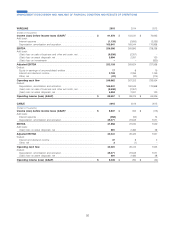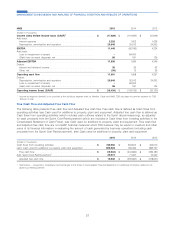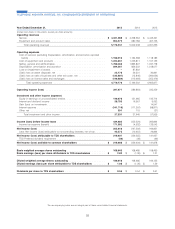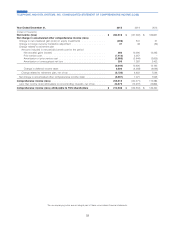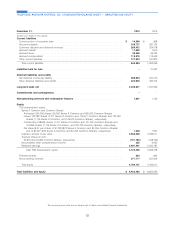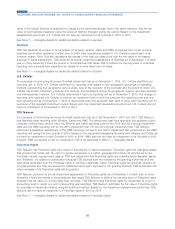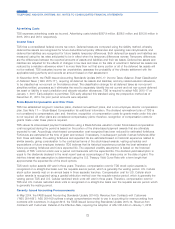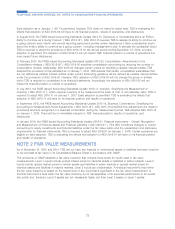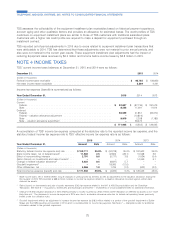US Cellular 2015 Annual Report Download - page 74
Download and view the complete annual report
Please find page 74 of the 2015 US Cellular annual report below. You can navigate through the pages in the report by either clicking on the pages listed below, or by using the keyword search tool below to find specific information within the annual report.
NOTE 1 SUMMARY OF SIGNIFICANT ACCOUNTING POLICIES AND
RECENT ACCOUNTING PRONOUNCEMENTS
Nature of Operations
Telephone and Data Systems, Inc. (‘‘TDS’’) is a diversified telecommunications company providing high-quality services
to approximately 4.9 million wireless customers and 1.2 million wireline and cable connections at December 31, 2015.
TDS conducts all of its wireless operations through its 84%-owned subsidiary, United States Cellular Corporation (‘‘U.S.
Cellular’’). TDS provides broadband, video, voice and hosted and managed services through its wholly-owned
subsidiary, TDS Telecommunications Corporation (‘‘TDS Telecom’’).
TDS has the following reportable segments: U.S. Cellular, Wireline, Cable, and Hosted and Managed Services (‘‘HMS’’)
operations. TDS’ non-reportable other business activities are presented as ‘‘Corporate, Eliminations and Other’’. This
includes the operations of TDS’ wholly-owned subsidiary Suttle-Straus, Inc. (‘‘Suttle-Straus’’). Suttle-Straus’ financial
results were not significant to TDS’ operations. All of TDS’ segments operate only in the United States, except for HMS,
which includes an insignificant foreign operation. See Note 18 — Business Segment Information for summary financial
information on each business segment.
Principles of Consolidation
The accounting policies of TDS conform to accounting principles generally accepted in the United States of America
(‘‘GAAP’’) as set forth in the Financial Accounting Standards Board (‘‘FASB’’) Accounting Standards Codification
(‘‘ASC’’). Unless otherwise specified, references to accounting provisions and GAAP in these notes refer to the
requirements of the FASB ASC. The consolidated financial statements include the accounts of TDS, its majority-owned
subsidiaries, general partnerships in which it has a majority partnership interest and variable interest entities (‘‘VIEs’’) in
which TDS is the primary beneficiary. Both VIE and primary beneficiary represent terms defined by GAAP.
Intercompany accounts and transactions have been eliminated.
Reclassifications
Certain prior year amounts have been reclassified to conform to the 2015 financial statement presentation. In the fourth
quarter of 2015, TDS adopted, on a retrospective basis, Accounting Standards Update 2015-03, Simplifying the
Presentation of Debt Issuance Costs (‘‘ASU 2015-03’’). See discussion of ASU 2015-03 below under Debt Issuance
Costs.
Use of Estimates
The preparation of consolidated financial statements in conformity with GAAP requires management to make estimates
and assumptions that affect (a) the reported amounts of assets and liabilities and disclosure of contingent assets and
liabilities at the date of the financial statements and (b) the reported amounts of revenues and expenses during the
reported period. Actual results could differ from those estimates. Significant estimates are involved in accounting for
goodwill and indefinite-lived intangible assets, income taxes and equipment installment plans.
Cash and Cash Equivalents
Cash and cash equivalents include cash and highly liquid investments with original maturities of three months or less.
Accounts Receivable and Allowance for Doubtful Accounts
U.S. Cellular’s accounts receivable consist primarily of amounts owed by customers for wireless services and equipment
sales, including sales of certain devices under equipment installment plans through its owned and agent distribution
channels, by agents for sales of equipment to them and by other wireless carriers whose customers have used U.S.
Cellular’s wireless systems.
TDS Telecom’s accounts receivable primarily consist of amounts owed by customers for services and products provided,
by interexchange carriers for long-distance traffic which TDS Telecom carries on its network, and by interstate and
intrastate revenue pools that distribute access charges.
The allowance for doubtful accounts is the best estimate of the amount of probable credit losses related to existing
billed and unbilled accounts receivable. The allowance is estimated based on historical experience, account aging and
66
TELEPHONE AND DATA SYSTEMS, INC. NOTES TO CONSOLIDATED FINANCIAL STATEMENTS


